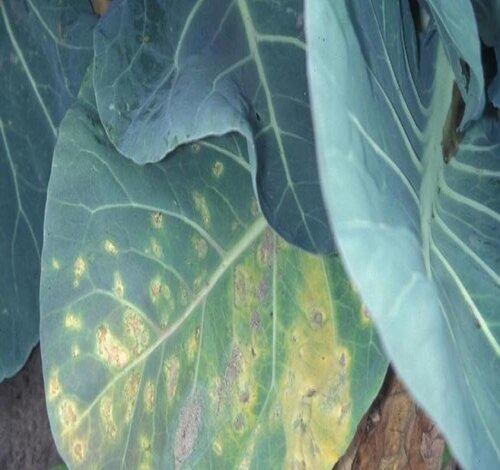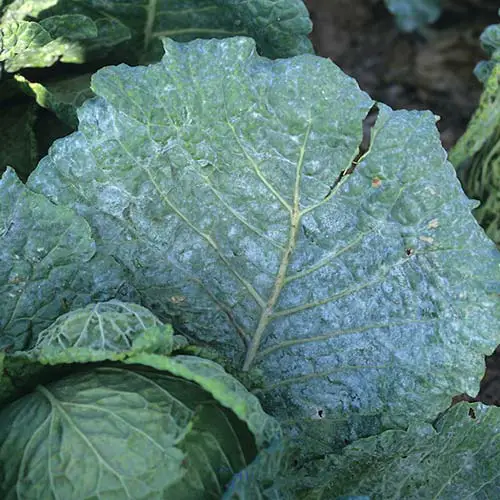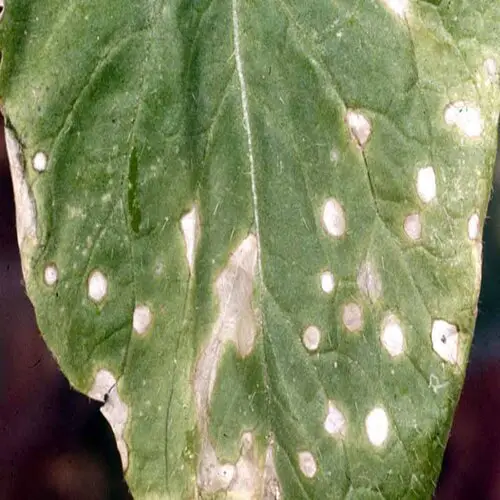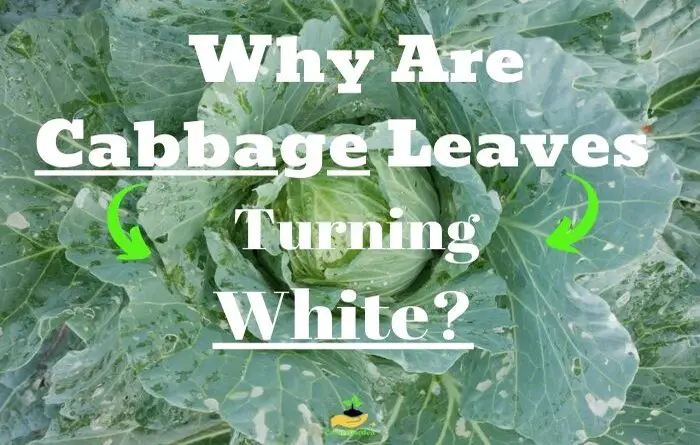Cabbage Leaves Turning White? [Here’s How To Fix It]
Everyone knows that the color of healthy cabbage leaves should be different shades of green, depending on its age and variety. But often gardeners are faced with the fact that cabbage leaves are turning white.
White spots on cabbage leaves appear as a result of nutrient deficiencies, sunburn or damage to the vegetable by diseases like downy mildew, white leaf spot or white mold.
| Why are Cabbage Leaves Turning White: |
|---|
| 1. Nutrients Deficiency |
| 2. Sunburn |
| 3. Downey Mildew |
| 4. Powdery Mildew |
| 5. White Leaf Spot |
| 6. Blackleg |
| 7. White Mold |
1. Nutrients deficiency
Cabbage plants need a number of crucial elements to develop and prosper, and a deficiency in these minerals might result in the leaves turning white.
The most frequent nutritional deficiency that can make cabbage leaves turn white is a deficiency in nitrogen. The formation of chlorophyll, the pigment that gives leaves their green hue, depends heavily on nitrogen, a vital nutrient.
Lack of nitrogen in the soil prevents plants from producing enough chlorophyll, which causes the leaves to become white or yellow.
Whitening of the leaves can also be caused by a lack of other crucial minerals like zinc and magnesium.
The appropriate mix of nutrients must be given to the cabbage plants in order to prevent nutritional deficits. You may accomplish this by utilizing a superior fertilizer that has been created especially for use with cabbage plants.
Magnesium deficiency
Some gardeners cannot understand why cabbage leaves are turning white in the upper part and what needs to be done about it. The appearance of white spots in cabbage usually occurs due to insufficient magnesium content in the soil.
If the cabbage leaf brightens from the top, and the veins below are green (leaf marbling), then the cabbage lacks magnesium.
In this case, the upper parts of the leaves become whitish. Magnesium deficiency will lead to the rapid death of the leaves and the death of the crop in full.
If nothing is done about it, then the entire crop in the garden will die. In the garden center, you can buy a special top dressing with magnesium, and then apply it to the soil in the garden. Easily absorbable fertilizers give very fast results.
The solution to this problem is carried out by feeding the seedlings with compounds prepared on the basis of magnesium sulfate.
Potassium deficiency
If white spots appear on the lower leaves of the cabbage, and the leaves begin to turn yellow along the edges, then there is not enough potassium.
The production of robust cell walls is one of the many processes that potassium is essential for in the general health of the cabbage.
The leaves may become fragile and brittle due to a shortage of potassium, which may result in damage and discoloration.
When the cabbage bush becomes whiter and the bottom leaves dry out, add potassium sulfate as soon as possible.
If, in addition to these signs, the leaves are covered with dark veins, then the bush needs manganese with iron. In the absence of copper, the upper foliage brightens and dries.
Calcium deficiency
If the leaves lighten or are turning white, this means that the cabbage lacks calcium and potassium. I advise you to fertilize with homemade infusions such as banana peel infusion and wood ash.
Treatment should be carried out as follows:
Take 5-7 banana peels, chop and place in a bucket, add a liter of ash to the mixture and pour everything with water. Insist for a day or two and that’s all. Before fertilizing, you should stir everything, strain and pour 0.5-0.7 liters of fertilizer under each cabbage under the root.
Of course, you can also buy nutrient fertilizers, but the above remedy, I think, is less dangerous, and the effect of it is very good.
| Cabbage Nutrient deficiency | Treatment |
|---|---|
| 1. Magnesium | Magnesium sulfate (23g/m2) |
| 2. Calcium | Calcium Nitrate (60-100g/m2) |
| 3. Potassium | Potassium sulfate (5-10g/m2) |
| 4. Nitrogen | Ammonium nitrate (20-25 g/m2) |
2. Sunburn
Sunburn is the second factor that causes cabbage leaves to become white. The chlorophyll, which gives cabbage leaves their green color, starts to deteriorate when the leaves are exposed to excessive sunshine.
This is due to the absence of the pigments that give leaves their color, which exposes the white or pale-yellow underlying tissue.
As the chlorophyll in the leaves degrades, overexposure to sunshine can make cabbage plants vulnerable and render their leaves white.
Sunburn is more frequent in locations with high levels of sunshine or during hot weather. Additionally, it can happen if the cabbage plants are cultivated in an area that receives the most of its sunlight directly, such as a south-facing garden bed or a sunny window.
Treatment
Cabbage plants should be cultivated in an area that receives some shade during the warmest portion of the day to prevent sunburn.
The cabbage may be planted behind taller plants to do this, or it can be covered with shade cloth or another type of cover during the warmest parts of the day. Furthermore, sufficient watering can aid in keeping the leaves cool and lower the danger of sunburn.
Maintaining correct spacing between the cabbage plants is another approach to avoid sunburn. The leaves of crowded plants fight with one another for light and space, which may make them more vulnerable to sunburn.
To provide enough room for the leaves to grow and to prevent crowding, it is crucial to thin out the plants.
3. Downy Mildew

White spots on cabbage leaves usually appear if the plant is infected with downy mildew, a common disease of many vegetable crops. It’s caused by Peronospora parasitica, a moisture mold (oomycete), formerly known as a fungus.
This dangerous illness begins with lesions on the upper side of the leaves, with white to gray clumps of fungal spores visible on the cabbage’s lower leaves surfaces.
If your cabbage seedlings become sick, the entire vascular system can become black. When your cabbages become infected with downy mildew, you may be unable to eat them.
Fog, heavy dew, moisture, and drizzly rains all contribute to the growth and spread of downy mildew, infection-friendly temperatures at night ranging from 46 to 61°F, with daytime highs of 75°F or less.
Downy mildew is especially problematic in fall crops in locations with moist and mild winters, such as Washington State. The pathogen can infect crops throughout the winter, setting the groundwork for significant spring infections in favorable conditions.
To worsen this situation, white rust can invade downy mildew-weakened host plants.
There are actions that you can take to prevent downy mildew, such as removing cruciferous weeds and giving plants plenty of room to grow rather than crowding them in too tightly. Proper airflow reduces humidity and makes illnesses less likely.
Another possibility is to plant in the spring and reap in the summer.
Treatment
If your cabbages are infested with downy mildew, you can control it with fungicides and copper-based preparations.
Spraying with copper sulfate or Bordeaux liquid gives the greatest effect, but you can also use any other copper-based preparations.
Copper ideally destroys fungi and therefore usually one spray at the initial stage of the disease is enough to stop its development.
It is even better to treat the soil with a solution of copper sulfate in advance before planting cabbage, because powdery mildew spores are usually found in the surface layer of the soil.
Space the plants to avoid high densities which prevent air circulation and maintain humidity levels favorable to the development of the disease.
4. Powdery Mildew

Powdery mildew is also a disease that causes a variety of cabbage leaves to turn white. It is formed by Erysiphe cruciferarum, a fungus that requires a living host to reproduce, so it will not usually harm your cabbages. However, you should develop resistant cultivars because infected plants yield smaller heads.
The symptoms begin with white sores on the tops of the leaves. As the fungus grows and spreads, the leaves will become powdery white on both sides due to spores.
Crops are more susceptible to infection when they are water starved. The fungus usually spends the winter on cruciferous weeds, then the spores are blown to their hosts.
Powdery mildew grows best at temperatures ranging from 59 to 68 degrees Fahrenheit and low humidity.
Treatment
Fungicides are rarely needed, but if the infection is severe, apply neem oil to the afflicted plants.
Purging host plants such as wild radish and mustard will reduce the likelihood of your crop becoming infected. Avoid drought conditions by irrigating regularly and avoiding the overuse of nitrogen fertilizer.
5. White Leaf Spot

The fungus causes circular, white to yellow spots about 1 centimeter in diameter, sometimes accompanied by dark streaks and other spots.
White Leaf Spot on cabbage is a rare disease that often coincides with heavy winter rains. When conditions are favorable, a fuzzy white growth can be observed on the leaf spots, characteristic of the spores.
Ascospores develop on infected plants in the fall and are then dispersed by the wind. The asexual spores, or conidia, are spread by rain or splashing water, resulting in secondary spread of the disease.
Temperatures of 50-56°F (10-16°C), along with humid conditions, favor the appearance of this fungal disease.
In some cases this disease can cause great losses. Rapeseed, Chinese cabbage, turnip and mustard appear to be more susceptible to the disease than other brassica species such as broccoli and cauliflower. Wild radish, shepherd’s purse, radish, horseradish, and wild mustard are also prone to fungus.
Treatment
The pathogen does not survive in the soil but does live on weeds and cabbage plants. The disease can also be transmitted through seeds and residues of infected crops.
Unfortunately, there is no control measure for brassica white leaf spot and its only treatment involves the removal and destruction of infected plants.
Therefore, prevention is the best method of control. Use only disease-free seeds or resistant cultivars. Practice crop rotation every three years and proper sanitation when disposing of infected material. Avoid planting near where it has been previously infected and control weeds and cruciferous plants.
6. Blackleg
Phoma lingam is a fungus that causes blackleg and kills the roots of numerous crops. This could be one of the major reasons why your cabbage leaves are turning white.
Young cabbage seedlings may have white, uneven spots on their leaves or stems that might grow into round or oval shapes with gray cores. White areas on the underside of the leaves can form as the symptoms spread.
In the event of a severe infection, young cabbages will be stunted, and seedlings will frequently wilt, even though the leaves will remain attached. The first signs of blackleg are light brown, deep cankers at the base of the stems. Dark brown or black patches on the leaves of diseased cabbages might form if they are picked and stored.
This fungus can persist in crop residue and spread by infected seeds. Cruciferous weeds are also potential hosts. Even if seed infection levels are minimal, but the weather is conducive to disease, substantial losses can occur.
The infection can spread through splashing water from rainfall or irrigation, as well as through gardening equipment. Furthermore, spores on diseased plants can be carried for miles in the wind.
To make matters worse, secondary diseases usually follow blackleg episodes. White mold and bacterial soft rot are examples of these. There isn’t much you can do when your crop is diseased, so implementing preventative measures is critical.
Treatment
Any cruciferous weeds, such as wild radish, yellow cress, or wild mustard, should be removed. Begin with seeds from a reliable supplier that have been proven pathogen-free.
Plants should be spaced widely in the garden to allow for proper ventilation, and they should dry rapidly after rain or dew. Remove diseased crop debris from the garden as soon as possible.
Please place it in the trash rather than your compost pile. Plant cabbage in rotation for three to four years, and limit planting additional brassicas near where you intend to grow your cabbage.
7. White Mold
Lastly, the presence of white leaves on cabbage may indicate the development of white mold, otherwise called Sclerotinia sclerotiorum, but other parts of the plant, such as a head of cabbage, are also affected by this disease.
Sclerotinia sclerotiorum is a widespread fungus that can infect over 300 plant types causing the cabbage leaves to turn white. While white mold can infect cabbages in the open, it can also cause storage losses.
White Mold is an issue in humid weather with temperatures ranging from 50 to 77°F.
The fungus penetrates the stem first. It can then move down to the bases and upwards towards the leaves, prompting them to wilt and causing the plants to collapse. White cottony growth on or inside the tissues is one of the symptoms. This is how the sickness got its name.
The fungus generates reproductive structures known as sclerotia, contributing to the disease’s virulence. These resemble black seeds and can survive in the soil for years. These sclerotia are sometimes apparent in infected tissue.
Infection thrives in moist environments. If the weather becomes dry after an infection has taken hold, you may notice brown cankers that do not spread further, mainly on a stem.
Controlling white mold infection combines cultural approaches, including proper sanitation, well-drained soil, weed management, and extended crop rotations. Cultivating the soil’s last planting will provide adequate drainage, which is necessary to minimize moisture buildup.
Treatment
Early infection treatment is more likely to be beneficial than treating a severe infection that has already significantly advanced. A mixture of fungicides and biopesticides might be used to manage white mold. Treatments using Bacillus amyloliquefaciens with Bacillus subtilis may be beneficial.
Benomyl is a type of fungicide that has been recommended for treating white mold on cabbage, but you should check with your local gardening center to see which fungicides are approved to treat this infection in your area.
How to Prevent White Spots on Cabbage Leaves
You can prevent cabbage leaves from turning white by paying attention to the following measures:
- Treat planting material with fungicides before sowing.
- Observe crop rotation and plant seedlings in a permanent place so that the bushes are not too dense.
- Spray the soil in seedling boxes and beds with a solution of sulfur-containing preparations.
- Spray young plants with fungicide solutions before transferring them to open ground.
- Check seedlings and mature cabbage regularly for signs of infection.
- An infusion of fresh nettles will increase the immunity of the crop.
Frequently Asked Questions
White spots on cabbage leaves appear as a result of damage to the vegetable by downy mildew, or white rot. This fungal disease, which is effectively eliminated by treatment with fungicides, can also be used Bordeaux mixture, or copper sulfate.
Photosynthesis requires light and chlorophyll. If there is not enough light, then chlorophyll is destroyed. Therefore, the upper leaves of a head of cabbage, which receive enough light, have chlorophyll, green. The inner leaves are white, as they do not have enough light.
White plaque on the leaves of cabbage seedlings , which becomes denser over time, indicates that they are affected by powdery mildew.
Over time, affected plants change the shape of the leaves and stems. Then the affected leaves completely dry out and fall off.




